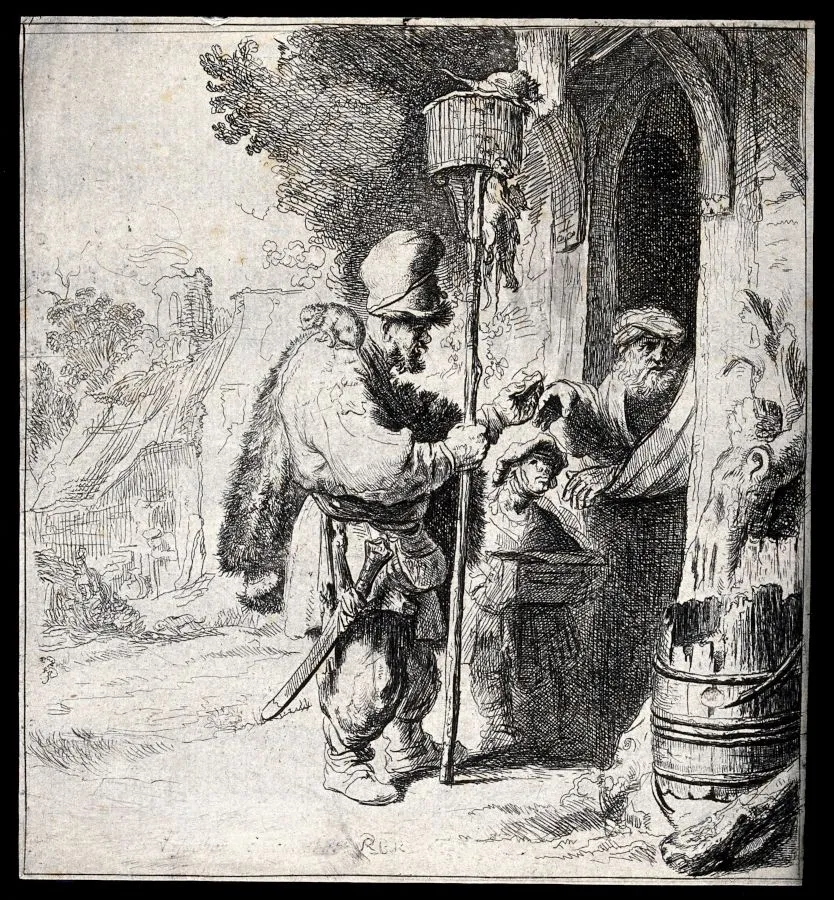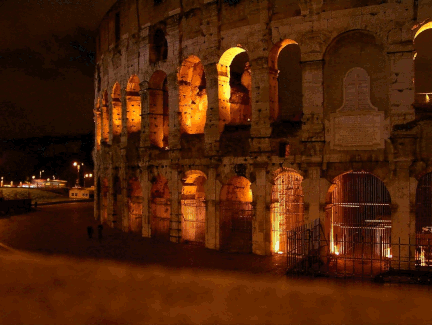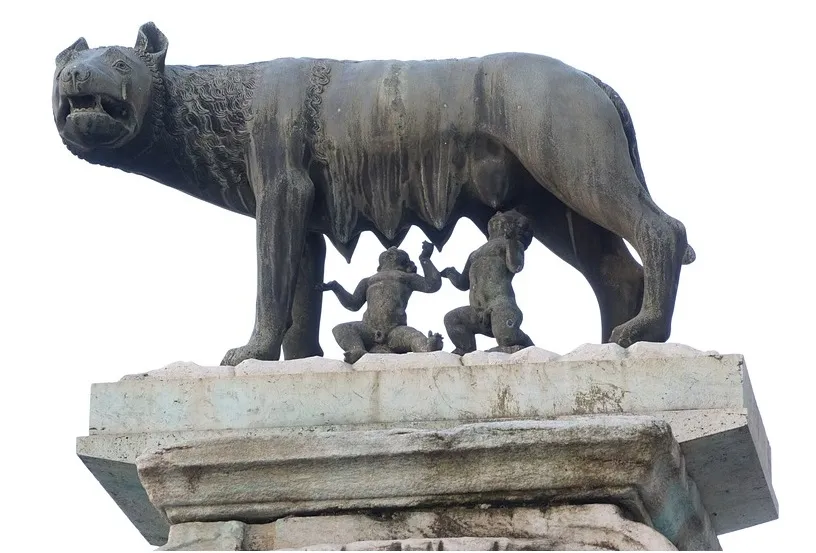
A look at the template (photo by @shaka, below) for LMAC #208 clearly reveals the inspiration for my collage. I extracted the statues from the top of the building and created a scene with these as a major feature.
Template by @shaka

While the human figures at the center of the collage may seem to be most important, perhaps we are overlooking a significant player in this scene: the rat (socializing with the cats) in the lower left hand corner.
Rats in Human History

Credit: Rat Catcher With Young Assistant, Rembrandt. 1632. Wellcome Trust. CC 4.0 license.
Rats have played a role in human history out of proportion to their diminutive size. Most of us know about the bubonic plague, the Black Death, or whatever it might be called. This was a devastating pandemic that descended in waves on Europe and other parts of the world. The rat has been blamed for spreading Y. Pestis, the pathogen that causes the disease.
This is a sobering indictment of the rat, and well deserved. The animal spreads not only plague bacillus, but also other pathogens. However, I'm here to say something good about the rat today. This animal has contributed a great deal to human health through its domestication as a research subject.
Today's laboratory rat is a direct descendant of the Norway rat. This rat was the first mammal domesticated for laboratory use.

Norway rat: Credit Ian Kirk from Broadstone, Dorset, UK . CC 2.0 license
Recently, it has been discovered that the humble rat can also serve as a witness to the social evolution of human history.
Rats cannot travel very far on their own. They have been distributed across the globe as stowaways on human transportation. A palaeogenomic analysis of the rat gives us information about human activity and human migration. Where we go, eventually, the rat goes. The rat gene may give us clues into otherwise discrete aspects of human history.
Imagine how warm and snug the stowaways on the Santa Maria were. A replica of the ship that carried Columbus from Europe to the Americas in 1492 is pictured below.

Credit: Moai. Public domain.
In 2022 Discover magazine published a Newsletter that detailed how scientists gain insights into human history by tracking genomic sequencing of rat species. The authors of the article assert, "The ability of rats to colonise, and become dependent upon anthropogenic niches makes them ideal bioproxies to track historical processes." In other words, as humans travel and adapt to changing environments, rats also evolve to accommodate those adaptations.
One event in the human journey through time that has confounded historians is the collapse of the Roman Empire (you see, I did bring the blog back to my collage 😇). While a number of causes have been cited for the decline of this great empire, no one can say for sure what brought about its failure. However, in looking at variations in the density and distribution of rat populations over the years of decline, scientists think they might find some clues for the cause, or causes of the empire's disintegration.
With the economic collapse of the Roman Empire, and with a disintegration of its trade networks, there was a comparable decrease in the rat population. The Discover article states that the falloff in the number of rats, "... may be evidence that the network of well-connected settlements that once supported thriving black rat colonies had collapsed".
It was pretty obvious to me when I looked at the template that I would use the statues to populate a picture about Ancient Rome. The wolf in the background (barely visible in the collage) is the legendary wolf that suckled Remus and Romulus. You can see them under the wolf if you look at the picture very closely. Here is a better shot of that legendary scene.
The orator in the collage is likely an emperor who ruled after the republic had descended into autocracy. The ruins of the Colosseum represent the empire in decline. Finally, the eroding civic cohesion of Rome's citizens is suggested by the guards carrying daggers. They need the daggers to control the spectators.
This may all be a bit too symbolic, but I had fun adding those touches :)
The rat was an afterthought. Once I put the cats there, the rat was a natural complement. Apparently, cats were highly regarded in Ancient Rome. One website suggests that the phrase, The cat did it, originated with the Roman playwright Aristophanes.
Elements used in my collage are listed below. Thank you to everyone who helped me realize what I intended.
Pixabay
Statue in the forum
https://pixabay.com/es/photos/italia-roma-foro-bronce-estatua-2505857/Coliseum
https://pixabay.com/es/photos/coliseo-roma-turismo-antiguo-2698193/Chariot
https://pixabay.com/es/photos/boudicca-boadicea-carruaje-caballos-359043/Wolf--Remus and Romulus
https://pixabay.com/es/photos/r%C3%B3mulo-y-rafi-colina-capitolina-1701556/Roman hills
https://pixabay.com/es/photos/roma-foro-palatino-palatino-colina-4824914/
LIL
Cat
@yaziris
https://www.lmac.gallery/lil-gallery-image/7654Red cat
@redheadpei
https://www.lmac.gallery/lil-gallery-image/7006
Here is a GIF that shows some of the steps I went through to get the final result.

LIL is not only a valuable image resource for the Hive community, but is also a way for community members to participate in LMAC. Anyone on Hive can contribute to the library and everyone can borrow from it. Learn about the procedure here.
Every week we offer prizes to fifteen finalists in the contest, but it's not only the prizes people create for. I, for example, don't compete but spend hours giving vent to my imagination. Others in the community have developed the habit of 'speaking' through collage.
This week's contest has concluded. But a new contest will begin on Thursday, with a brand new template. Please join in the fun.
As @shaka has said many times, everyone is an artist. I may not be an artist in the technical sense, but LMAC allows me to nurture my own unique artistic voice.
Thank you for reading. Peace and health to all.

